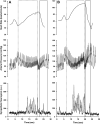Morning sympathetic activity after evening binge alcohol consumption
- PMID: 33185112
- PMCID: PMC7864252
- DOI: 10.1152/ajpheart.00743.2020
Morning sympathetic activity after evening binge alcohol consumption
Erratum in
-
Corrigendum for Greenlund et al., volume 320, 2021, p. H305-H315.Am J Physiol Heart Circ Physiol. 2024 Apr 1;326(4):H1061-H1063. doi: 10.1152/ajpheart.00743-2020_COR. Am J Physiol Heart Circ Physiol. 2024. PMID: 38568842 Free PMC article. No abstract available.
Abstract
Binge alcohol consumption elicits acute and robust increases of muscle sympathetic nerve activity (MSNA), yet the impact of evening binge drinking on morning-after MSNA is unknown. The present study examined the effects of evening binge alcohol consumption on polysomnographic sleep and morning-after MSNA. We hypothesized that evening binge drinking (i.e. 4-5 drink equivalent in <2 h) would reduce sleep quality and increase morning-after blood pressure (BP) and MSNA. Following a familiarization night within the sleep laboratory, 22 participants (12 men, 10 women; 25 ± 1 yr) were examined after simulated binge drinking or fluid control (randomized, crossover design). Morning MSNA was successfully recorded across both conditions in 16 participants (8 men, 8 women) during a 10-min baseline and three Valsalva's maneuvers (VM). Binge drinking reduced rapid eye movement (REM) sleep (15 ± 1 vs. 20 ± 1%, P = 0.003), increased stage II sleep (54 ± 1 vs. 51 ± 1%, P = 0.002), and increased total urine output (2.9 ± 0.2 vs. 2.1 ± 0.1 liters, P < 0.001) but did not alter morning-after urine specific gravity. Binge drinking increased morning-after heart rate [65 (54-72) vs. 58 (51-67) beats/min, P = 0.013] but not resting BP or MSNA. Binge drinking elicited greater sympathoexcitation during VM (38 ± 3 vs. 43 ± 3 bursts/min, P = 0.036). Binge drinking augmented heart rate (P = 0.002), systolic BP (P = 0.022), and diastolic BP (P = 0.037) reactivity to VM phase IV and blunted cardiovagal baroreflex sensitivity during VM phases II (P = 0.028) and IV (P = 0.043). In conclusion, evening binge alcohol consumption disrupted REM sleep and morning-after autonomic function. These findings provide new mechanistic insight into the potential role of binge drinking on cardiovascular risk.NEW & NOTEWORTHY Chronic binge alcohol consumption is associated with future cardiovascular disease (CVD) risk in both men and women. In addition, binge alcohol consumption is known to disrupt normal sleep quality during the early morning hours, coinciding with the morning sympathetic surge. In the present study, an evening of binge alcohol consumption increased baseline morning heart rate and cardiovascular reactivity during the Valsalva maneuver (VM) strain. Specifically, muscle sympathetic nerve activity and phase IV hemodynamic responses increased during VM the morning after binge alcohol consumption. The autonomic dysfunction and increased cardiovascular reactivity during VM suggests a contributing mechanism to CVD risk present in individuals who binge drink.
Keywords: autonomic activity; baroreflex sensitivity; ethanol; hypertension; sleep.
Figures





Similar articles
-
Cardiovascular and aortic wave reflection responses to evening binge alcohol consumption.Am J Physiol Heart Circ Physiol. 2025 Sep 1;329(3):H629-H635. doi: 10.1152/ajpheart.00466.2025. Epub 2025 Aug 1. Am J Physiol Heart Circ Physiol. 2025. PMID: 40748681 Clinical Trial.
-
Binge Alcohol Consumption Elevates Sympathetic Transduction to Blood Pressure: A Randomized Controlled Trial.Hypertension. 2024 Oct;81(10):2140-2151. doi: 10.1161/HYPERTENSIONAHA.124.23416. Epub 2024 Aug 9. Hypertension. 2024. PMID: 39119705 Clinical Trial.
-
Evening binge alcohol disrupts cardiovagal tone and baroreflex function during polysomnographic sleep.Sleep. 2021 Nov 12;44(11):zsab130. doi: 10.1093/sleep/zsab130. Sleep. 2021. PMID: 34015116 Free PMC article. Clinical Trial.
-
Alcohol use disorders and the heart.Addiction. 2019 Sep;114(9):1670-1678. doi: 10.1111/add.14703. Epub 2019 Jul 15. Addiction. 2019. PMID: 31309639 Free PMC article. Review.
-
Holiday Heart Syndrome: A Literature Review.Cureus. 2025 Feb 28;17(2):e79816. doi: 10.7759/cureus.79816. eCollection 2025 Feb. Cureus. 2025. PMID: 40161046 Free PMC article. Review.
Cited by
-
Sleep, alcohol, and caffeine in financial traders.PLoS One. 2023 Nov 8;18(11):e0291675. doi: 10.1371/journal.pone.0291675. eCollection 2023. PLoS One. 2023. PMID: 37939019 Free PMC article.
-
Effects of alcohol on sleep and nocturnal heart rate: Relationships to intoxication and morning-after effects.Alcohol Clin Exp Res. 2022 Oct;46(10):1875-1887. doi: 10.1111/acer.14921. Epub 2022 Sep 1. Alcohol Clin Exp Res. 2022. PMID: 35953878 Free PMC article. Clinical Trial.
-
Blood pressure and muscle sympathetic nerve activity are associated with trait anxiety in humans.Am J Physiol Heart Circ Physiol. 2023 Apr 1;324(4):H494-H503. doi: 10.1152/ajpheart.00026.2023. Epub 2023 Feb 17. Am J Physiol Heart Circ Physiol. 2023. PMID: 36800506 Free PMC article.
-
Effects of Greater Central Arterial Stiffness on Cardiovagal Baroreflex Sensitivity in Resistance-Trained Men.Sports Med Open. 2021 Oct 26;7(1):77. doi: 10.1186/s40798-021-00367-x. Sports Med Open. 2021. PMID: 34698951 Free PMC article.
-
Daily stress predicts later drinking initiation via craving in heavier social drinkers: A prospective in-field daily diary study.J Psychopathol Clin Sci. 2022 Oct;131(7):780-792. doi: 10.1037/abn0000771. Epub 2022 Sep 1. J Psychopathol Clin Sci. 2022. PMID: 36048091 Free PMC article.
References
-
- National Institutes of Health. Rethinking drinking: alcohol and your health. National Institute on Alcohol Abuse and Alcoholism; No. 10-3770 (Revised April 2010): 1–18, 2010.
Publication types
MeSH terms
Grants and funding
LinkOut - more resources
Full Text Sources
Other Literature Sources

